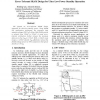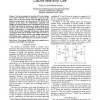54 search results - page 1 / 11 » Low power SRAM techniques for handheld products |
ISLPED
2005
ACM
13 years 10 months ago
2005
ACM
SRAM leakage constitutes a significant portion of the standby power budget of modern SoC products for handheld applications such as PDA and cellular phones. NMOS and PMOS reverse ...
ISQED
2008
IEEE
13 years 11 months ago
2008
IEEE
We present an error-tolerant SRAM design optimized for ultra-low standby power. Using SRAM cell optimization techniques, the maximum data retention voltage (DRV) of a 90nm 26kb SR...
ISQED
2010
IEEE
13 years 6 months ago
2010
IEEE
A new SRAM design is proposed. Body biasing improves the static noise margin (SNM) improved by at least 15% compared to the standard cells. Through using this technique, lowering ...
JSA
2000
13 years 4 months ago
2000
Portable products are being used increasingly. Because these systems are battery powered, reducing power consumption is vital. In this report we give the properties of low power d...
ISCAS
2007
IEEE
13 years 11 months ago
2007
IEEE
- Data in conventional six transistor (6T) static random access memory (SRAM) cells are vulnerable to noise due to the direct access to the data storage nodes through the bit lines...


